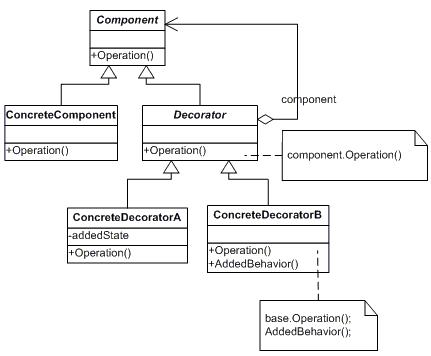
using System;
using System.Collections.Generic;
namespace DoFactory.GangOfFour.Decorator.RealWorld
{
class MainApp {
static void Main() {
// Create book
Book book = new Book(“Worley”, “Inside ASP.NET”, 10);
book.Display();
// Create video
Video video = new Video(“Spielberg”, “Jaws”, 23, 92);
video.Display();
// Make video borrowable, then borrow and display
Console.WriteLine(“nMaking video borrowable:”);
Borrowable borrowvideo = new Borrowable(video);
borrowvideo.BorrowItem(“Customer #1”);
borrowvideo.BorrowItem(“Customer #2”);
borrowvideo.Display();
// Wait for user
Console.ReadKey();
}
}
/// <summary>
/// The ‘Component’ abstract class
/// </summary>
abstract class LibraryItem {
private int _numCopies;
// Property
public int NumCopies
{
get { return _numCopies; }
set { _numCopies = value; }
}
public abstract void Display();
}
/// <summary>
/// The ‘ConcreteComponent’ class
/// </summary>
class Book : LibraryItem
{
private string _author;
private string _title;
// Constructor
public Book(string author, string title, int numCopies) {
this._author = author;
this._title = title;
this.NumCopies = numCopies;
}
public override void Display() {
Console.WriteLine(“nBook —— “);
Console.WriteLine(” Author: {0}”, _author);
Console.WriteLine(” Title: {0}”, _title);
Console.WriteLine(” # Copies: {0}”, NumCopies);
}
}
/// <summary>
/// The ‘ConcreteComponent’ class
/// </summary>
class Video : LibraryItem
{
private string _director;
private string _title;
private int _playTime;
// Constructor
public Video(string director, string title, int numCopies, int playTime) {
this._director = director;
this._title = title;
this.NumCopies = numCopies;
this._playTime = playTime;
}
public override void Display() {
Console.WriteLine(“nVideo —– “);
Console.WriteLine(” Director: {0}”, _director);
Console.WriteLine(” Title: {0}”, _title);
Console.WriteLine(” # Copies: {0}”, NumCopies);
Console.WriteLine(” Playtime: {0}n”, _playTime);
}
}
/// <summary>
/// The ‘Decorator’ abstract class
/// </summary>
abstract class Decorator : LibraryItem
{
protected LibraryItem libraryItem;
// Constructor
public Decorator(LibraryItem libraryItem){
this.libraryItem = libraryItem;
}
public override void Display(){
libraryItem.Display();
}
}
/// <summary>
/// The ‘ConcreteDecorator’ class
/// </summary>
class Borrowable : Decorator {
protected List<string> borrowers = new List<string>();
// Constructor
public Borrowable(LibraryItem libraryItem)
: base(libraryItem)
{
}
public void BorrowItem(string name){
borrowers.Add(name);
libraryItem.NumCopies–;
}
public void ReturnItem(string name) {
borrowers.Remove(name);
libraryItem.NumCopies++;
}
public override void Display() {
base.Display();
foreach (string borrower in borrowers) {
Console.WriteLine(” borrower: ” + borrower);
}
}
}
}